Guardbridge geothermal technology demonstrator project: feasibility report
Report of the study exploring the potential of a geothermal district heating system accessing hot sedimentary aquifer resources underlying Guardbridge, Fife.
10. Economic Analysis
A technical and economic model was developed for the project on the basis of the technical operation and the capital, operational, replacement costs and revenues. The core element in the methodology is an Excel model that offers an overview of the profitability to enable decision making by each of the stakeholders in the project (Appendix B).
The Excel model interacts with important data sources from the remainder of the study, notably the energy demands, predicted system operation and the economic assumptions. These are handled separately in order to make the basic model simple and transparent.
The scenario presented in the economic model is based on a district heating network that connects all proposed buildings on the Guardbridge site. In the short term, the heat supply is assumed to be provided by the biomass energy centre, until sufficient baseload exists to justify investment in the geothermal well and heat pump system. The model assumes the well can sustain 15 l/s of water at a temperature of 25 ºC giving a COP on the heat pump of 4.
Table 10.1: Well, heat pump and energy centre CAPEX.
| Item |
Central Cost Estimate (15 l/s) |
Percentage Variation ( ± ) |
|
|---|---|---|---|
| GB-2 well design in next phase |
£50,000 |
50% |
|
| Prepare site, mob rig, drill well GB-2 to 1000 m |
£945,000 |
21% |
-13% |
| Complete well and flow test |
£147,000 |
36% |
-5% |
| Water treatment plant |
£375,000 |
33% |
-33% |
| Water disposal to sea |
Incl |
||
| Sub-total well CAPEX |
£1,517,000 |
26% |
-17% |
| Water Source Heat Pump |
£183,935 |
10% |
-10% |
| Thermal Store |
£46,166 |
10% |
-10% |
| Balance of Plant |
£100,000 |
20% |
-20% |
| Building Works |
£193,548 |
10% |
-10% |
| Electricity Grid Connection |
£13,620 |
20% |
-20% |
| Sub-total Heat pump and heat station CAPEX |
£537,269 |
12% |
-12% |
| TOTAL CAPEX |
£2,404,269 |
24% [2] |
-17% |
10.1 CAPEX
The district heating network CAPEX is estimated to be £530,000 for a total pipe network length of approximately 1,200m. A small cost of £40,000 has been included to account for the cost of connecting to the heat transmission main from the biomass energy centre (Table 10.1).
The model includes the cost of heat interface units for all customers but, as discussed below, these costs are assumed to be repaid by customers as a connection charge. This can be presented to customers as an avoided cost for installation of an alternative heating system.
10.2 OPEX and REPEX
The operational costs are estimated to be principally for the power consumption of the heat pump and distribution pumps to the district heating network. This equates to a cost of approximately £280,000 per year. The model assumes a major replacement and clean out of the well after 10 years at a cost of £250,000.
10.3 Revenue
The principal revenues in the model are the RHI and heat sales to consumers. The RHI has been assigned to the project at £50.8/MWh. The heat sales price is a variable and needs to reflect a competitive price against the alternative business case, which would be individual gas boilers or electric heat pumps. The price considered in the base model varies by customer size and is listed in Table 10.2.
Table 10.2: Assumed cost of heat to consumers.
| Customer size |
Heat sale price |
|
|---|---|---|
| Heat sales price 0-250 MWh |
47 |
p/kWh |
| Heat sales price 250-2500 MWh |
43 |
p/kWh |
| Heat sales price 2500-25000 MWh |
42 |
p/kWh |
| Heat sales price 25000-250000 MWh |
36 |
p/kWh |
10.4 Modelling results
The model generates a 20-year cashflow for the project based on the figures estimated from the analysis described in this report. It calculates the overall economic performance of the project to society in terms of the payback, internal rate of return ( IRR), net present value ( NPV), and return on investment. This result is useful to optimise the overall system, but the model also presents a transparent economic model that illustrates the benefit to each of the organisations. This is critical in establishing a delivery model that attracts all stakeholders of the system into the project.
Fig. 10.1: Share of benefit under district heating scenario presented.
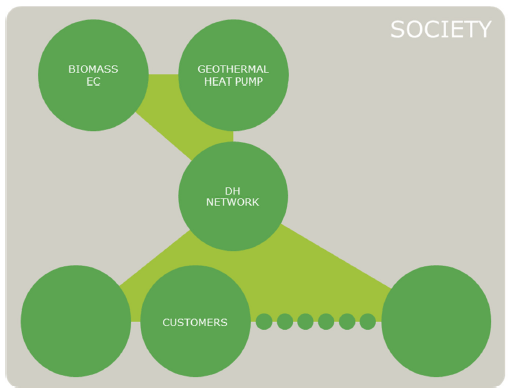
The modelling assumptions are presented in a clear and transparent way. The model considers the effect of a range of financing options for the different scenarios, and is run on the basis of the financial parameters for the district heating network shown in Table 10.3. The financing of the geothermal well and energy centre is likely to require specific project investment criteria and for the purposes of this analysis, the NPV and IRR are assumed to provide suitable parameters to assess the viability. The NPV presented in this report for the geothermal well and energy centre is calculated on the basis of a 3% [3] discount rate.
The financial projections are in real terms and do not include inflation. One option will be to finance with the cheapest international 20-year loans on the market (assuming a public sector or state guarantee for the loan). Another option is to assume a private equity financing and a specified return on the invested capital. The model can be adjusted to reflect the revenues from a specified competitive heat price and the result will be an additional short term financing at a specified interest rate.
Table 10.3: Financial parameters assumed in the model (related to the DHN).
| Parameter |
Unit |
Assumption |
|---|---|---|
| Discount rate |
% |
3% |
| Inflation |
% |
2% |
| Nominal interest rate, long-term loan |
% |
5% |
| Nominal interest rate, short-term credit negative |
% |
6% |
| Nominal interest rate, short-term credit positive |
% |
4% |
| Depreciation of district heating investments |
Years |
20 |
Table 10.4: Key variables affecting performance of the network under conservative expected performance.
| Variables |
Worst Case |
Central Case |
Best Case |
|||
|---|---|---|---|---|---|---|
| Value |
Range/Units |
Value |
Range/Units |
Value |
Range/Units |
|
| COP |
300% |
400% |
500% |
|||
| Well & heat Pump CAPEX |
-10% |
± 10% |
0% |
± 10% |
-10% |
± 10% |
| Network CAPEX |
0% |
± 10% |
0% |
± 10% |
-10% |
± 10% |
| Electricity price to large heat pump |
11.25 |
p/kWh |
11.25 |
p/kWh |
8 |
p/kWh |
| Heat Sales Price to Customers |
0% |
± 10% |
0% |
± 10% |
15% |
± 10% |
| Heat Price from Biomass EC |
41 |
£/MWh |
41 |
£/MWh |
30 |
£/MWh |
| Heat Price from Geothermal |
50 |
£/MWh |
50 |
£/MWh |
61 |
£/MWh |
| Customer connection contribution for Branch & HIU |
100% |
100% |
100% |
|||
| Alternative heat supply in absence of district heating |
Gas Boiler |
Gas Boiler |
Heat Pump COP 2.5 |
|||
| Heat pump operation year |
2017 |
2017 |
2017 |
|||
| RHI included |
Yes |
Yes |
Yes |
|||
The biomass energy centre is assumed to supply the back-up and peaking heat capacity to the network and this will come from a heat exchanger connected to a branch off the main network. The cost of heat advised by the University of St Andrews is 41 p/kWh which covers the cost of an assumed capacity charge of £30,000 per year.
The results for the central scenario (Fig. 10.2) indicate that neither the large heat pump or the district heating network make a positive return if the consumers are supplied with heat at a competitive price compared to the gas boiler alternative. Table 10.5 illustrates how the performance of the network improves under the best case conditions.
Table 10.5: Economic results for scenario modelled on data in Table 10.4.
| NPV k£ |
IRR (%) |
NPV k£ |
IRR (%) |
NPV k£ |
IRR (%) |
|
|---|---|---|---|---|---|---|
| Supplier, Surplus heat |
-347 |
3% |
50 |
3% |
87 |
3% |
| Large heat pump |
-555 |
-3% |
-597 |
-2% |
967 |
10% |
| District heating company |
-359 |
-7% |
-399 |
-7% |
218 |
10% |
| Consumers |
44 |
44 |
1,567 |
|||
| Total benefit to society |
-1,217 |
-6% |
-902 |
-2% |
2,839 |
28% |
Fig. 10.2: Representation of share of benefit as NPV to each of the stakeholders in the project.
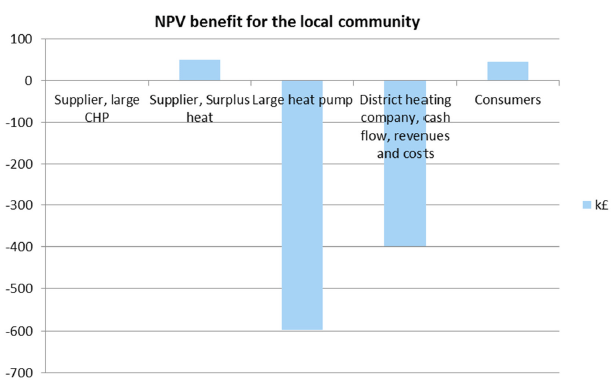
10.4.1 Heating Customer Perspective
The tool presents, for the given solution of heat supply to the Guardbridge site, a comparative assessment of heat price between District Heating and other heat supply options. This demonstrates the relative benefit to customers of connection against the business as usual alternative.
Fig. 10.3: Comparative representation of share of benefit as NPV to each of the stakeholders in the project under best case scenario.
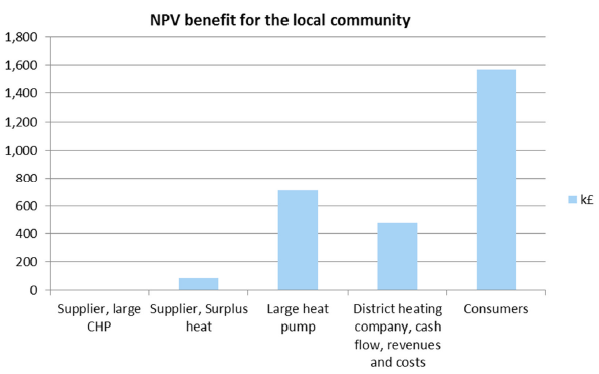
Table 10.6 indicates that each customer, due to their relative size and heat offtake, will have a variable saving from district heating compared to the business as usual alternative. These alternatives are considered to be gas boilers or electric heat pumps. It is notable that small consumers benefit from district heating most under a heat pump alternative and large consumers benefit most under a gas boiler alternative.
Table 10.6: Comparison between business as usual ( BAU) and alternative heating options for consumers compared to 42 p/kWh heat from DH.
| Building |
Saved cost arising from DH |
|
|---|---|---|
| gas boiler alternative |
individual heat pump alternative |
|
| Offices, Labs, R&D, Workshops 1 |
2% |
12% |
| Offices, Labs, R&D, Workshops 2 |
8% |
13% |
| Library/ Archive Facility 30km linear of storage |
8% |
13% |
| Offices for Library staff |
3% |
15% |
| Offices above Library |
4% |
13% |
| Brewery |
-23% |
25% |
| Data Centre |
9% |
10% |
| Energy Centre Admin and Visitor centre |
3% |
15% |
| Innovation & Research Centre |
-7% |
8% |
| Former Boiler House (Listed) |
-3% |
10% |
| Data Centre Expansion |
12% |
14% |
| Light Industrial 1 |
0% |
16% |
| Light Industrial 2 |
-1% |
11% |
| Offices, Labs, R&D, Workshops 3 |
9% |
14% |
| Offices, Labs, R&D, Workshops 4 |
-1% |
16% |
| Offices, Labs, R&D, Workshops 5 |
7% |
13% |
| Future Brewery Expansion |
-1% |
16% |
| Store |
3% |
15% |
10.4.2 District Heating Company Perspective
The district heating operator in this scenario generates an IRR and NPV of 3% hurdle rate. The project under these conditions would not offer a payback after 21 years, despite the residual value of the district heating pipes. Under the best case scenario however, and with a higher heat price to the geothermal well, the network would potentially achieve a positive IRR and NPV which could be commercially viable.
10.4.3 Biomass energy centre perspective
Heat from the biomass energy centre will provide the back-up and peaking demand to the network. The cost of heat from this plant will be related principally to the fuel cost to the plant and also to the cost of gas if the demand displaces load on the network. The central estimate of £41/MWh is based on a cost of heat of £20/MWh and the cost or financing a £40k connection from the transmission pipe and a £30k per year share of the operation and maintenance cost. Under this scenario, the energy centre makes a small profit on the sale of heat.
Fig. 10.4: Lifecycle cost for district heating network including residual value at end of period under best case scenario.
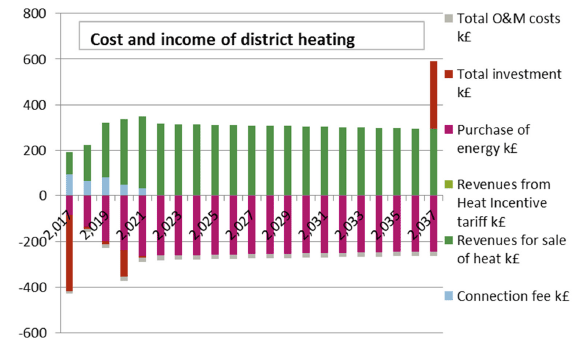
10.4.4 Geothermal well and heat pump perspective
Under the scenario considered, the geothermal well generates at a peak capacity of 418 kW and can provide approximately 50% of the load on the network. The heat sales price is too low in this scenario to create sufficient margin to make the economic performance attractive. This is principally due to the capital cost of the geothermal well and high operational margin required to pay back the investment. The best case scenario shows that this might achieve a 10% IRR and a positive NPV.
10.5 Carbon emissions
The generation of heat from the geothermal well, using a heat pump to increase the flow temperature, offers potential carbon emissions reductions. These have been compared to a business as usual ( BAU) scenario that includes individual gas boilers for each of the customers (Table 10.7). The heat production in the alternative business case requires heat supply of 113,351MWh to be generated by gas boilers. This equates to 28,574 tonnes of carbon emissions. The analysis in the model shows an 84% reduction in carbon emissions under a scenario where biomass boilers and water source heat pumps supply the majority of the demand through a local district heating network.
The carbon emissions factor associated with the biomass boilers is 7 kgCO 2/kWh th based on the carbon emissions of different fuels, provided by the Biomass Energy Centre website ( www.biomassenergy.org.uk). The carbon emissions factor associated with the electricity grid is 300 kgCO 2/kWh and this is predicted to reduce over the lifecycle of the project. The reduction in grid emissions intensity has been included in the model based on Figure 5.2 in the DECC report enetitled Updated Energy & Emissions Projections - November 2015.
Under the scenario modelled for this study, the biomass boilers contribute approximately 50% of the heat demand (up to 3 MWh per year) and the heat pumps contribute the remaining 50% of the demand. The biomass boilers have low carbon emissions associated with them and the majority of the predicted CO 2 emissions are associated with the carbon emissions intensity of the grid supplying the geothermal well pumps and the heat pump. This equates to 4,677 tonnes over the 20-year lifetime of the model. These are significantly lower than the alternative scenario where heating is supplied from gas boilers. Furthermore, the carbon intensity of the electricity grid is reducing with the build out of low carbon energy generation systems connecting to the electricity grid. About 58% (13,878 tonnes CO2/kWh saved relative to the BAU) of the carbon emissions reduction is attributed to the heat supplied from the biomass plant and 9,812 tonnes CO2/kWh saved relative to the BAU (42%) is attributed to the geothermal well pumps and the heat pumps.
Table 10.7: Carbon emissions reductions from district heating compared to individual gas boilers.
| 20 Year Lifecycle Carbon Emissions Reduction |
||
|---|---|---|
| Total CO 2 emission district heating |
4,677 |
Tonnes |
| Total CO 2 emission baseline |
28,574 |
Tonnes |
| Saved CO 2 emission district heating compared to baseline |
23,987 |
Tonnes |
The value of this carbon saving is not included in the model since it does not currently represent a cost to the University, however it could be considered to represent an additional saving compared to the BAU alternative. The following items are excluded from the above calculation of carbon emissions:
- the embodied carbon emissions associated with the manufacturing and transport of the buildings, plant and equipment;
- any carbon emissions associated with degassing the well which are expected to be negligible;
- carbon emissions associated with the produciton, drying and transport of biomass to the biomass boiler plant.
10.6 Sensitivity
As noted previously the model calculates the overall economic performance of the project to society in terms of the payback, IRR, NPV and return on investment. This economic benefit to society is shared between the stakeholders. The economic performance in the model is sensitive to a series of variables. Some of these represent internal transactions within the model and do not affect the economic performance for the whole society, but do influence the share of the benefit between individual customers.
The following parameters are critical in the model for distributing the benefits among the various organisations but do not affect the overall project economics:
- Heat Price from Geothermal
- Heat Sales Price to Customers
- Customer connection contribution for Branch & HIU
- Cost of heat from biomass Energy Centre
The following parameters were varied and the influence on the overall economic performance or the benefit to individual organisations is discussed.
1. Variation in source temperature and Heat Pump COP
An increase in the temperature that the resource could sustainably deliver would enhance the COP of the heat pump. Varying the COP from 4 to 5 improves the project IRR from 3% to 4% and the IRR for the energy centre from 0% to 1%.
2. Well and heat pump capital costs
The CAPEX for the well and heat pump has a significant effect. A 10% reduction on the CAPEX improves the project IRR from 3% to 5% and the IRR for the energy centre from 0% to 3%. A 10% increase on the CAPEX reduces the project IRR from 3% to 1% and the IRR for the energy centre from 0% to -3%.
3. Timing of heat pump operation
The uncertain development of the heat load at the site, and the opportunity to supply heat from the biomass energy centre, means that it may be prudent to wait until the load is guaranteed before investing in the geothermal well. This is feasible and does not affect the overall cost assumptions, but delays the investment in the network. Establishing the network from 2017 and investing in the heat pump in 2020 improves the IRR from 3% to 4%.
4. Renewable heat incentive ( RHI)
The RHI is vital to the economic viability of the project and will allow the demonstration of the project with the expectation that the lessons learnt from installing deep geothermal wells can be shared, and the costs and risks of installation can be reduced generally. The removal of the RHI from the modelling assumptions reduces the overall IRR to society from 3% to -2%.
10.7 Summary of Economic Analysis
Based on the economic analysis, the project can demonstrate reasonable performance under a scenario where the anticipated geothermal resource can yield the predicted performance and the costs and risks are well managed. The model clearly shows, however, that the economic performance of the scheme is sensitive to a number of factors and it is the combination of sensitivities that need to be considered. Tables 10.4 and 10.5 indicate the relative performance under the baseline set of assumptions and a reasonable best case assumption.
The results in Table 10.5 indicate that the central estimate for the project delivers a -2% IRR and the district heating company generates a negative IRR and NPV. The geothermal system will deliver a negative IRR and NPV over a 20-year lifetime. This result will make the geothermal system, with the inherent risk of not reaching the required permeability in the rock, a poor investment prospect. It is notable, however, that there are a number of sensitivities that could improve the model performance and this scenario has been presented below.
The results presented as the best case scenario in Table 10.5 show a significantly more attractive project. The assumptions made in this scenario are not unreasonable, but will require further investigation, although they do not provide a margin for uncertainty and risk. The cashflow for this scenario is shown in Figure 10.5.
Fig. 10.5: Financial result for the investment in the district heating network only.
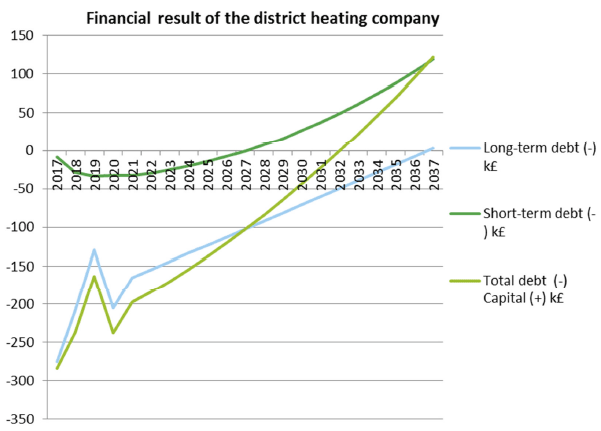
Contact
There is a problem
Thanks for your feedback